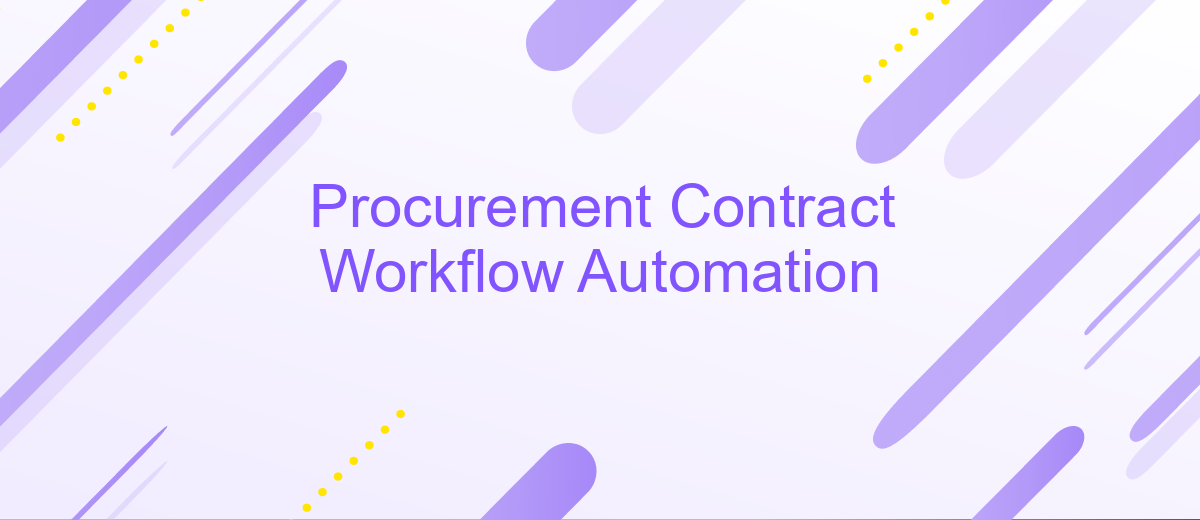Procurement Contract Workflow Automation
In today's fast-paced business environment, procurement contract workflow automation is becoming essential for organizations seeking efficiency and accuracy. By automating the procurement process, companies can reduce manual errors, streamline operations, and ensure compliance with regulatory standards. This article explores the benefits, key features, and implementation strategies of procurement contract workflow automation, highlighting its critical role in modern business practices.
Introduction
Procurement contract workflow automation is revolutionizing the way organizations manage their purchasing processes. By streamlining and automating various stages of procurement, businesses can achieve greater efficiency, accuracy, and compliance. This transformation is essential for reducing manual errors, speeding up approval processes, and ensuring that all contractual obligations are met promptly.
- Enhanced efficiency and speed in procurement processes
- Reduction in manual errors and administrative overhead
- Improved compliance and risk management
- Seamless integration with existing systems
One of the key enablers of this automation is the integration of advanced tools and services. ApiX-Drive, for example, offers robust integration capabilities that allow businesses to connect various procurement systems effortlessly. By leveraging such services, organizations can ensure that their procurement workflows are not only automated but also highly synchronized with other business processes, leading to a more cohesive and efficient operational environment.
Benefits of Procurement Contract Workflow Automation

Procurement contract workflow automation offers significant benefits by streamlining the entire procurement process. One of the primary advantages is the reduction of manual errors and time-consuming tasks. Automated workflows ensure that each step of the contract management process is executed accurately and efficiently, minimizing the risk of human error. This leads to faster processing times and allows procurement teams to focus on more strategic activities, enhancing overall productivity and efficiency.
Another key benefit is the improved visibility and control over the procurement lifecycle. Automation tools provide real-time tracking and monitoring of contract statuses, enabling better compliance and risk management. Integration with services like ApiX-Drive can further enhance these benefits by seamlessly connecting various systems and applications, ensuring a smooth data flow and reducing the need for manual data entry. This integration capability helps organizations to maintain a cohesive and transparent procurement process, ultimately leading to more informed decision-making and better supplier relationships.
Steps to Automate a Procurement Contract Workflow

Automating a procurement contract workflow can significantly streamline operations, reduce errors, and ensure compliance. To achieve this, it is essential to follow a structured approach, leveraging modern tools and technologies.
- Identify Key Processes: Begin by mapping out the key steps in your procurement contract workflow, from initial request to final approval and storage.
- Select Automation Tools: Choose appropriate software solutions that can automate each step. Tools like ApiX-Drive can facilitate seamless integration between different systems.
- Configure Workflows: Set up automated workflows within your chosen software, ensuring that each step triggers the next action automatically.
- Integrate Systems: Use services like ApiX-Drive to integrate your procurement software with other enterprise systems, such as ERP and CRM, to ensure data consistency.
- Test and Optimize: Conduct thorough testing of the automated workflow to identify any issues. Optimize the process based on feedback and performance metrics.
- Train Staff: Provide training to your team on using the new automated system to ensure smooth adoption and maximum efficiency.
By following these steps, organizations can achieve a more efficient and reliable procurement contract workflow, ultimately saving time and resources while ensuring compliance and accuracy.
Challenges and Considerations

Implementing procurement contract workflow automation can present several challenges that organizations must carefully consider. One of the primary concerns is the integration of the new system with existing enterprise resource planning (ERP) and procurement software. Ensuring seamless data flow between systems is crucial to avoid disruptions in operations.
Another significant challenge is managing the change within the organization. Employees accustomed to manual processes may resist transitioning to an automated system. Providing adequate training and support is essential to facilitate this change and ensure user adoption.
- Data Security: Protecting sensitive procurement data from breaches.
- Compliance: Ensuring the system adheres to regulatory requirements.
- Customization: Tailoring the automation solution to fit specific organizational needs.
- Integration: Utilizing services like ApiX-Drive to streamline connections between various software platforms.
Addressing these challenges requires a strategic approach, involving collaboration between IT, procurement, and compliance teams. By leveraging tools like ApiX-Drive, organizations can achieve smoother integrations and enhance the overall efficiency of their procurement contract workflows.


Conclusion
The automation of procurement contract workflows represents a significant advancement in streamlining and optimizing procurement processes. By leveraging modern technologies, organizations can achieve higher efficiency, reduce manual errors, and ensure compliance with established procurement policies. This transformation not only saves time but also enhances the overall transparency and accountability within the procurement cycle.
Integrating automation tools like ApiX-Drive further simplifies the process by enabling seamless integration with various existing systems and platforms. ApiX-Drive's capabilities in setting up integrations without the need for coding expertise make it an invaluable asset for organizations looking to enhance their procurement workflows. As businesses continue to evolve, embracing procurement contract workflow automation will be crucial for maintaining competitive advantage and operational excellence.
FAQ
What is procurement contract workflow automation?
How can procurement contract workflow automation benefit my organization?
Is it difficult to implement procurement contract workflow automation?
Can I integrate procurement contract workflow automation with my existing systems?
What should I look for in a procurement contract workflow automation tool?
Strive to take your business to the next level, achieve your goals faster and more efficiently? Apix-Drive is your reliable assistant for these tasks. An online service and application connector will help you automate key business processes and get rid of the routine. You and your employees will free up time for important core tasks. Try Apix-Drive features for free to see the effectiveness of the online connector for yourself.

